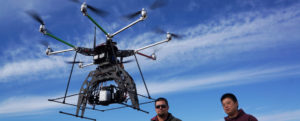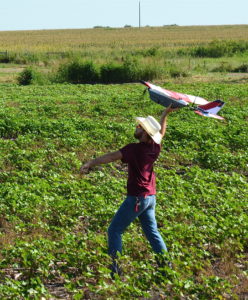By Blair Fannin, AgriLife Today
COLLEGE STATION – From traditional crop production to livestock, Texas A&M AgriLife Research scientists from across the state provided updates on a multitude of unmanned aerial systems, or UAS, projects recently in College Station.
The AgriLife Research UAS program is one of the largest in the U.S., according to faculty and administrators. The research program is utilizing both fixed-wing and rotary-wing aircraft as part of research activities at centers in Weslaco, Beaumont, Corpus Christi, College Station and Amarillo.
“We are progressing at a steady pace in all aspects of our UAS research program,” said Misty Vidrine, AgriLife Research UAS program coordinator in College Station. “We have the capability of developing intelligent pattern recognition models that can allow both the farmer and the rancher to make production management decisions, predict yield and detect abiotic and biotic crop stress in the field. These UAS modeling tools can dramatically help with improving the profitability of an operation.”
The AgriLife Research UAS program is one of the largest in the U.S., according to faculty and administrators. The research program is utilizing both fixed-wing and rotary-wing aircraft as part of research activities at centers in Weslaco, Beaumont, Corpus Christi, College Station and Amarillo. (Texas A&M AgriLife Research photo)
Program areas are broad, but tie back to either plant breeding or precision agriculture, Vidrine said. Researchers involved in the multidisciplinary project include biological and agricultural engineers, soil scientists, plant breeders, plant pathologists, plant physiologists, remote sensing scientists, geospatial scientists, civil engineers, mechanical and aerospace engineers, entomologists, animal scientists, rangeland specialists, social scientists and agricultural economists.
Dr. Megan Clayton, Texas A&M AgriLife Extension Service range specialist in Corpus Christi, gave an overview of work done in the livestock program.
“What we’ve found (through this technology) is we can improve the sustainability of grazing management,” Clayton said. “We’ve found we can soon provide tools to managers, which can suggest stocking rates, develop models, and test forage and herbage mass predictions, all types of datasets that can assist in livestock operations.”
The recent meeting was an update on work conducted in 2017. There was optimism among scientists at the meeting and excitement continues to build on what lies ahead with regards to breakthrough technologies to assist Texas farmers and ranchers and beyond in achieving higher yields and production, according to attendees.
“This research program overall is one of the most unique anywhere,” said Dr. Alex Thomasson, AgriLife Research biological and agricultural research engineer in College Station.
Texas A&M AgriLife Research unmanned aerial systems, or UAS, program areas are broad, but tie back to either plant breeding or precision agriculture. (Texas A&M AgriLife Research photo by Blair Fannin)
Researchers at the meeting also expressed optimism over new discoveries in wheat production. The wheat research has focused on different environmental conditions, such as drought, utilizing both ground and aerial data.
“The statewide wheat breeding program uses a remote sensing approach to utilize ground- and aerial-based measurements to evaluate wheat lines for reaction to biotic and abiotic stresses and maximize phenotyping efficiency,” said Dr. Amir Ibrahim, AgriLife Research wheat breeder in College Station.
Dr. Lee Tarpley, AgriLife Research plant physiologist at Beaumont, provided an update on a research project focused on grain crops. The specific objectives of the research is to evaluate leaf nitrogen and stress levels in rice as well as leaf water potential in both rice and corn. Tarpley said the work will help farmers be proactive and save money.
“We would like to be able to provide site prescriptions to improve crop profitability,” Tarpley said. “We’d like to be specific enough to allow remedies to be applied before economic losses occur.”
Tarpley said farmers typically treat entire fields when a specific crop disease is diagnosed. Through their research, they hope to develop tools to be site specific, lowering the cost of expensive crop inputs and improving crop revenues.
For more about the agency’s UAS research activities, visithttps://uasag.tamu.edu/.


